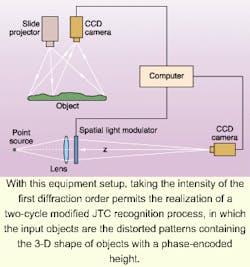Although most of the existing methods for pattern recognition through optical correlation have been developed for two-dimensional (2-D) objects, there is a growing need to extend this function to three-dimensional (3-D) objects. Recent research in the area has centered on a few key techniques—including imaging with range cameras, joint transform correlators (JTCs), holography, and Fourier transform profilometry (FTP)—each of which has its limitations. Now researchers at the Universitat de Valencia (Valencia, Spain) have developed a hybrid method that combines the benefits of several of these techniques to produce rotation-invariant 3-D object recognition. Simplicity of the setup is a key benefit, according to researchers José Esteve-Taboada, Javier García, and Carlos Ferreira.
To understand their method it helps to briefly explore the limitations of the other 3-D techniques. For example, the main drawback of optical or digital processing over a range image is the need for a range camera, technology that often isn't readily available. In addition, combining JTCs with electronic processing of images obtained from several cameras requires a complex setup and considerable digital calculation time. In techniques based on holography, there is an altogether different problem. Determination of a hologram from a rough object often is related to the microstructure of that object's surface. Thus two 3-D objects with different microstructures would have low correlation even if similar in basic shape. Finally, with FTP, the 3-D shape of an object is obtained by projecting a grating on its surface and capturing 2-D images with a camera. If the axes of the projector and the camera are not coincident, there can be distortion in the fringe pattern used to encode the 3-D object information.
The technique developed in Valencia combines the FTP technique with a real-time recognition setup based on a JTC architecture and circular-harmonics (CH) decomposition, which essentially makes the method invariant for rotations around the line of sight (see figure). While a conventional JTC architecture requires placing the scene to be analyzed and the target side by side in the input plane, the hybrid technique has the joint input image composed of the deformed fringe patterns of the objects to be tested and a CH component. The latter, which acts as a reference function that carries part of the target's 3-D information, is the CH component of the phase-encoded height function of the target.
In essence, the method obtains the superposition of the Fourier transform of the phase-encoded height functions of the input objects, as well as that of the reference CH function. By grabbing the resulting intensity and performing a new Fourier transform, the researchers then can obtain the correlation between the phase-encoded height functions and the CH.
According to Esteve-Taboada and colleagues, the experimental setup for the hybrid optical-character recognition technique, except for the grabbing of the images and the a priori computation of the CH component, requires no electronic or digital processing. Moreover, says Esteve-Taboada, once the CH component derived from the target has been calculated, the system operates at nearly video rates, and both the reference function and the input scene can be rapidly changed to scan different filters or input objects.
The scientists see their technique used in equipment such as automatic vision systems that must classify, test, and track 3-D objects. While the hybrid optical character recognition method has some FTP-related limitations, they believe it will be easy to reduce them with minor equipment changes, for example with the use of an interference system to generate the grating and a telecentric camera lens.
REFERENCE
- J. Esteve-Taboada, J. García, and C. Ferreira, App. Opt. 39, 5998 (Nov. 10, 2000).
About the Author
Paula Noaker Powell
Senior Editor, Laser Focus World
Paula Noaker Powell was a senior editor for Laser Focus World.
